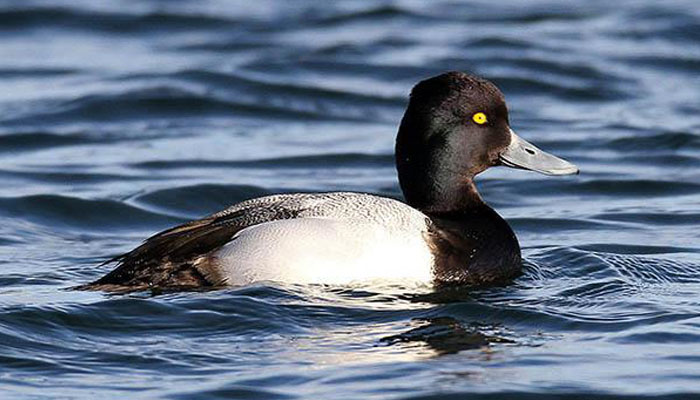
English: Greater Scaup, Bluebill,
Broadbill
Russian:
Морская чернеть
German: Bergente
French: Fuligule
milouinan
Mongolian: Тэнгисийн шумбуур
Japanese: スズガモ (Suzu-gamo)
Body length: 42-51 cm
Wing span: 71-80 cm
Habitat: Breeds
in habitats (fjords, archipelagos) on salt or brackish water, or on fresh-water
lakes and pools in mountains (birch and willow zones) and tundra. Migratory.
Wintering birds gregarious, diving for molluscs on open sea, or are seen along
coasts and in bays.
Identification:
Medium-sized with rather large, rounded head, and sloping and of body when
swimming. ♂ distinctive. Other plumage similar to Tufted Duck, with similar
white-bar, but note: no hint of crest on hindcrown; head shape more elongated
and profile smoothly rounded; body longer; and less black on tip of bill
(mainly just nail black; Tufted has whole tip black). Beware of confusing hybrids,
and the possibility of a rare vagrant Lesser Scaup.
- Adult
♂ breeding: Head black with green gloss, eye yellow; breast and stern black; flanks
white, back greyish-white (fine vermiculation apparent only at closer range) .
Bill pale grey with small, fan-shaped black nail patch. In flight, light back
usually obvious, as are white wing-bars; upper fore-edge of wing vermiculated,
appearing medium grey (darker than back but not black as on Tufted).
- Adult
♀: Dull brown with pale brown-grey flanks and slightly darker back, latter with
some greyish vermiculation (visible at close range only), and striking broad
white band surrounding base of bill (Tufted may have some white at bill-base
though usually less, and only rarely extending clearly over culmen). In late spring
/summer, a prominent pale patch on ear-coverts on most.
- Adult
♂ eclipse: Rather similar to breeding, but with brown cast on head, breast and
back, and often a little white around bill-base.
- Juvenile:
Resembles adult ♀, but less white at bill-base, slightly darker bill with
indistinct darker nail area, and paler flanks. Young ♂ attains most of adult
plumage by end of 1st winter, but not fully until 2nd winter.